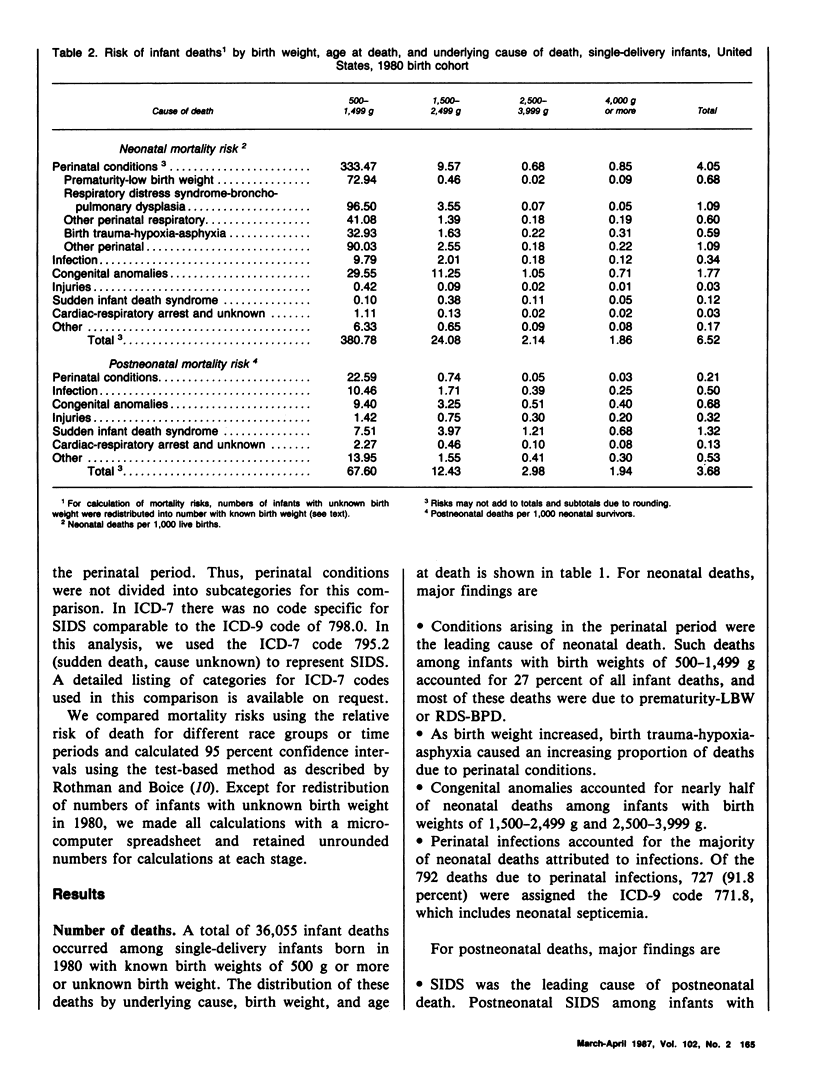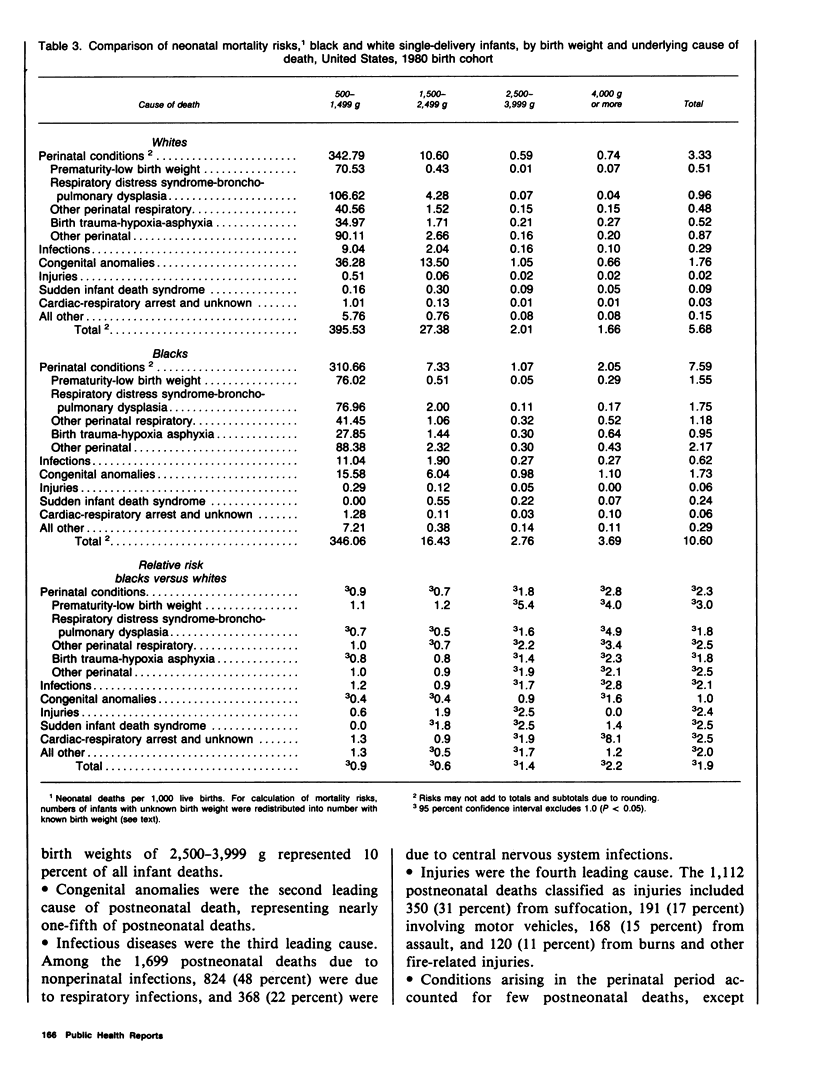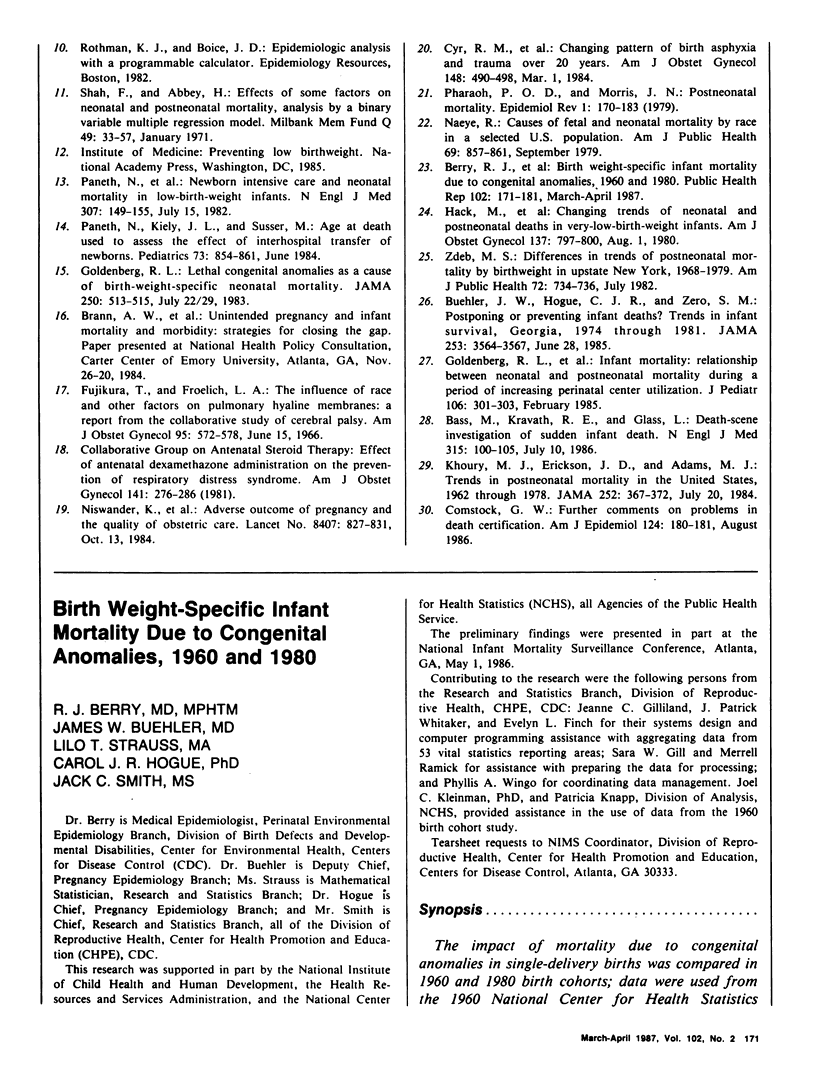Abstract
To describe underlying causes of infant death by birth weight, we used data from the 1980 National Infant Mortality Surveillance project and aggregated International Classification of Diseases codes into seven categories: perinatal conditions, infections, congenital anomalies, injuries, sudden infant death syndrome (SIDS), other known causes, and nonspecific or unknown causes. Compared with heavier infants, infants with birth weights of 500-2,499 grams (g) are at increased risk of both neonatal and postneonatal death for virtually all causes. Sixty-two percent of neonatal deaths (under 28 days of life) were attributed to "conditions arising in the perinatal period," as defined using codes from the International Classification of Diseases. Prematurity-low birth weight and respiratory distress syndrome (RDS) were the leading causes of such deaths among infants with birth weights of 500-2,499 g, while birth trauma-hypoxia-asphyxia and other perinatal respiratory conditions were the leading causes among heavier infants. For all birth weight groups, congenital anomalies were the second leading cause, representing 27 percent of neonatal deaths. Although perinatal conditions caused nearly one-third of postneonatal deaths (28 days to under 1 year of life) among infants with birth weights of 500-1,499 g, for the other birth weight groups these conditions were much less important; predominant causes of postneonatal death were sudden infant death syndrome (SIDS), congenital anomalies, infections, and injuries. Black infants had a roughly twofold higher risk of neonatal and postneonatal death than did white infants for all causes except congenital anomalies, which occurred with almost equal frequency in blacks and whites. However, for infants with birth weights of 500-2,499 g, blacks had lower risks of neonatal death from RDS and congenital anomalies. Between 1960 (the latest year for which national birth weight-specific mortality statistics had been available) and 1980, SIDS emerged as a major diagnostic rubric. Otherwise, except for infections and congenital anomalies among infants with birth weights of 500-1,499 g, all causes of death declined in frequency among all birth weight groups.
Full text
PDF









Selected References
These references are in PubMed. This may not be the complete list of references from this article.
- Bass M., Kravath R. E., Glass L. Death-scene investigation in sudden infant death. N Engl J Med. 1986 Jul 10;315(2):100–105. doi: 10.1056/NEJM198607103150206. [DOI] [PubMed] [Google Scholar]
- Berry R. J., Buehler J. W., Strauss L. T., Hogue C. J., Smith J. C. Birth weight-specific infant mortality due to congenital anomalies, 1960 and 1980. Public Health Rep. 1987 Mar-Apr;102(2):171–181. [PMC free article] [PubMed] [Google Scholar]
- Buehler J. W., Hogue C. J., Zaro S. M. Postponing or preventing deaths? Trends in infant survival, Georgia, 1974 through 1981. JAMA. 1985 Jun 28;253(24):3564–3567. doi: 10.1001/jama.253.24.3564. [DOI] [PubMed] [Google Scholar]
- Buehler J. W., Kleinman J. C., Hogue C. J., Strauss L. T., Smith J. C. Birth weight-specific infant mortality, United States, 1960 and 1980. Public Health Rep. 1987 Mar-Apr;102(2):151–161. [PMC free article] [PubMed] [Google Scholar]
- Comstock G. W., Markush R. E. Further comments on problems in death certification. Am J Epidemiol. 1986 Aug;124(2):180–181. doi: 10.1093/oxfordjournals.aje.a114376. [DOI] [PubMed] [Google Scholar]
- Cyr R. M., Usher R. H., McLean F. H. Changing patterns of birth asphyxia and trauma over 20 years. Am J Obstet Gynecol. 1984 Mar 1;148(5):490–498. doi: 10.1016/0002-9378(84)90733-6. [DOI] [PubMed] [Google Scholar]
- Fujikura T., Froehlich L. A. The influence of race and other factors on pulmonary hyaline membranes. A report from the Collaborative Study of Cerebral Palsy. Am J Obstet Gynecol. 1966 Jun 15;95(4):572–578. doi: 10.1016/0002-9378(66)90153-0. [DOI] [PubMed] [Google Scholar]
- Goldenberg R. L., Humphrey J. L., Hale C. B., Wayne J. B. Lethal congenital anomalies as a cause of birth-weight-specific neonatal mortality. JAMA. 1983 Jul 22;250(4):513–515. [PubMed] [Google Scholar]
- Goldenberg R. L., Koski J., Ferguson C., Wayne J., Hale C. B., Nelson K. G. Infant mortality: relationship between neonatal and postneonatal mortality during a period of increasing perinatal center utilization. J Pediatr. 1985 Feb;106(2):301–303. doi: 10.1016/s0022-3476(85)80311-5. [DOI] [PubMed] [Google Scholar]
- Hack M., Merkatz I. R., Jones P. K., Fanaroff A. A. Changing trends of neonatal and postneonatal deaths in very-low-birth-weight infants. Am J Obstet Gynecol. 1980 Aug 1;137(7):797–800. doi: 10.1016/0002-9378(80)90888-1. [DOI] [PubMed] [Google Scholar]
- Hogue C. J., Buehler J. W., Strauss L. T., Smith J. C. Overview of the National Infant Mortality Surveillance (NIMS) project--design, methods, results. Public Health Rep. 1987 Mar-Apr;102(2):126–138. [PMC free article] [PubMed] [Google Scholar]
- Khoury M. J., Erickson J. D., Adams M. J., Jr Trends in postneonatal mortality in the United States. 1962 through 1978. JAMA. 1984 Jul 20;252(3):367–372. [PubMed] [Google Scholar]
- Lambert D. A., Strauss L. T. Analysis of unlinked infant death certificates from the NIMS project. Public Health Rep. 1987 Mar-Apr;102(2):200–204. [PMC free article] [PubMed] [Google Scholar]
- Naeye R. Causes of fetal and neonatal mortality by race in a selected U.S. population. Am J Public Health. 1979 Sep;69(9):857–861. doi: 10.2105/ajph.69.9.857. [DOI] [PMC free article] [PubMed] [Google Scholar]
- Paneth N., Kiely J. L., Susser M. Age at death used to assess the effect of interhospital transfer of newborns. Pediatrics. 1984 Jun;73(6):854–861. [PubMed] [Google Scholar]
- Paneth N., Kiely J. L., Wallenstein S., Marcus M., Pakter J., Susser M. Newborn intensive care and neonatal mortality in low-birth-weight infants: a population study. N Engl J Med. 1982 Jul 15;307(3):149–155. doi: 10.1056/NEJM198207153070303. [DOI] [PubMed] [Google Scholar]
- Pharoah P. O., Morris J. N. Postneonatal Mortality. Epidemiol Rev. 1979;1:170–183. doi: 10.1093/oxfordjournals.epirev.a036209. [DOI] [PubMed] [Google Scholar]
- Shah F. K., Abbey H. Effects of some factors on neonatal and postneonatal mortality. Analysis by a binary variable multiple regression method. Milbank Mem Fund Q. 1971 Jan;49(1):33–57. [PubMed] [Google Scholar]
- Wigglesworth J. S. Monitoring perinatal mortality. A pathophysiological approach. Lancet. 1980 Sep 27;2(8196):684–686. doi: 10.1016/s0140-6736(80)92717-8. [DOI] [PubMed] [Google Scholar]
- Zdeb M. S. Differences in trends of postneonatal mortality by birthweight in upstate New York, 1968-1979. Am J Public Health. 1982 Jul;72(7):734–736. doi: 10.2105/ajph.72.7.734. [DOI] [PMC free article] [PubMed] [Google Scholar]


